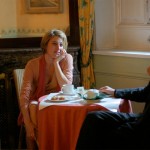Dir. by Nobuhiro Suwa
Look closely at the image above. It’s Un Couple parfait in miniature — a story told in body language. The husband (Bruno Todeschini) is an arm’s length from the table, his shoulders turned perpendicular to his wife. His cup sits untouched, reminding us, even moreso than the expression on his face, just how unwelcome these daily rituals of marriage have become. The wife (Valeria Bruni-Tedeschi) has a Mona Lisa smile. At first glance, she appears perfectly content — a woman deeply in love and endlessly curious, perhaps? But look at her eyes. They’re staring past her husband, lost in thought, wandering. There’s something absolutely beautiful to me about the way her right arm rests against her leg. And the way her body leans forward, gesturing toward him despite the growing distance.
The image is also a capsule of Suwa’s cinematographic style. There are maybe thirty-five shots in the entire film, all but a few from the fixed, static perspective of a waist-high camera positioned some distance from the characters. Suwa has said that, while working as an assistant director, he came to distrust the artificiality of traditional blocking. He chooses, instead, to allow room for his actors to move freely, to breathe and embody emotions more complex than those expressed in their dialogue. Language is slippery in Un Couple parfait. Or, not slippery, but irrelevant, maybe. Suwa isn’t at all interested in offering some metacommentary on the entanglements of postmodern discourse. Rather, his style — allowing actors to improvise lines while the camera is running, for example, or admitting, even, that he often did not understand exactly what his French actors were saying — is more humanist and psychological. Like an analyst, he observes quietly and respectfully the unspoken, looking for clues in behavior and movement, ripples from the subconscious.
Notice also the door that separates the characters from the camera. When asked why he so often underlights his actors, losing their faces in shadow, he said, “There are two ways to watch. One is to open your eyes and look closely; the other is to close your eyes and imagine.” Unlike so many filmmakers, Suwa clearly values the latter as much as the former, and his film is, on some level at least, a pedagogical instrument. At more than one point in Un Couple parfait, the husband and wife sit in adjoining hotel rooms. After one or the other shuts the door between them, Suwa lets his camera run, trapping our vision for a time. These, he claims, are his favorite moments in the film, for as we sit suspended, staring at the closed door, we’re also allowed room to move, to empathize or judge or imagine freely.
What you can’t see in the image are all of the subtle touches that make Un Couple parfait such a satisfying film. The look of wonder on Valeria Bruni-Tedeschi’s face as she wanders through a museum. The brief interruption of “reality” when an actor sneezes, another says “God bless you,” and they continue on with the scene. The occasional hand-held close-ups that jar you back into close identification with the characters, preventing the film from becoming a formal, intellectual exercise. The late-night conversation between Bruno Todeschini and an old man he meets in a cafe. Or the final scene, which rediscovers a cinematic cliche by taking the “irrelevance of language” to its logical extreme. Un Couple parfait is a kind of collision between the visions of Ingmar Bergman and Hou Hsiao-hsien: brutally incisive but always fascinated and tender.
